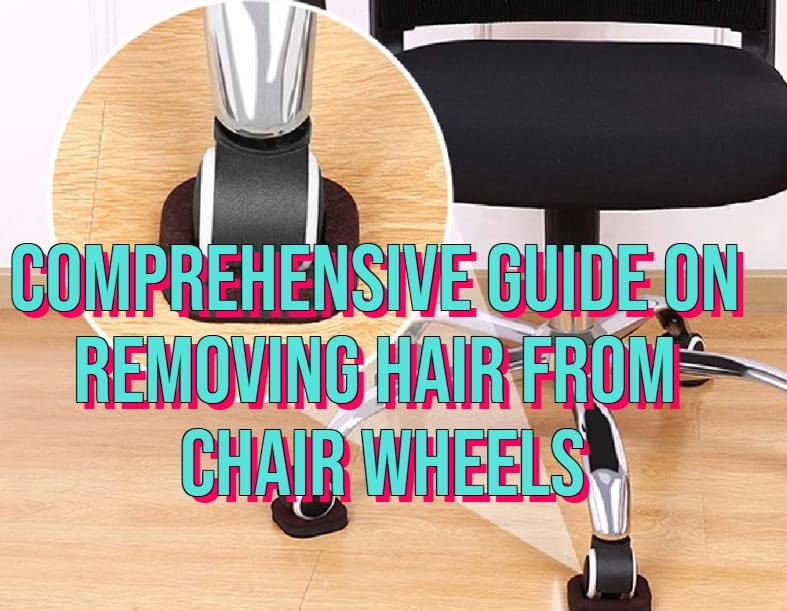Table of contents

Chair wheels are prone to accumulating hair, lint, and other debris over time, which can hinder their smooth movement and even damage flooring surfaces. Regular maintenance is crucial to ensure the longevity and optimal performance of chair wheels. In this comprehensive guide, we will explore various effective methods and techniques to remove hair from chair wheels, ensuring hassle-free mobility and cleanliness.
Understanding the Problem
Hair strands, especially long ones, have a tendency to wrap around chair wheels, axle pins, and casters. This accumulation can impede the smooth rotation of the wheels, leading to reduced mobility and potential damage to flooring surfaces. Additionally, the presence of hair on wheels can attract dust and other debris, further exacerbating the problem. Neglecting hair removal from chair wheels can have long-term consequences, such as excessive friction, premature wear and tear of the wheels, and compromised safety and comfort for users.
Preparing for the Hair Removal Process
Before starting the hair removal process, gather the necessary tools and materials. You will need latex or rubber gloves to ensure safety, a soft-bristle brush or toothbrush for loosening hair, adhesive tape or sticky rollers to capture hair, a vacuum cleaner with a brush attachment for efficient cleaning, mild detergent or cleaning solution, a clean cloth or sponge for wiping the wheels, and a lubricant such as silicone spray or WD-40 for enhanced hair removal.
Methods for Hair Removal from Chair Wheels
There are several methods you can employ to remove hair from chair wheels:
- Manual Removal with Fingers: Start by wearing gloves and visually inspect the chair wheels for hair accumulation. Using your fingers, gently grip the hair strands near the wheel’s axle or casters and pull them away. Repeat this process until all visible hair has been removed. Take caution not to damage the wheels or scratch the floor while pulling out the hair.
- Using a Soft Bristle Brush: If manual removal is not sufficient, use a soft-bristle brush or a toothbrush to loosen and dislodge the hair. Hold the brush at an angle and brush the wheels in a circular motion. Be gentle to avoid scratching the wheels or any nearby surfaces. After loosening the hair, proceed with manual removal using your fingers.
- Employing Adhesive Tape or Sticky Rollers: Adhesive tape or sticky rollers are effective tools for capturing hair from chair wheels. Wrap a piece of tape around your hand with the sticky side facing outward, or use a sticky roller specifically designed for cleaning purposes. Roll the adhesive tape or sticky roller over the wheels, applying gentle pressure to collect the hair. Repeat the process until the wheels are free of hair.
- Utilizing a Vacuum Cleaner: A vacuum cleaner with a brush attachment can help remove hair from chair wheels more efficiently. Attach the brush accessory to the vacuum cleaner hose and turn on the vacuum. Run the brush attachment along the wheels, focusing on areas with visible hair accumulation. The vacuum will suck up the loose hair, ensuring a thorough cleaning.
- Applying Lubrication for Enhanced Hair Removal: Lubrication can be beneficial for removing stubborn hair and preventing future accumulation. Apply a small amount of silicone spray or WD-40 to the wheels’ axles and casters. This lubrication helps to loosen the hair, making it easier to remove using one of the methods mentioned above.
Deep Cleaning and Maintenance
Periodically, it is essential to perform a deep cleaning of the chair wheels to remove any remaining hair and debris. Prepare a mild detergent or cleaning solution by diluting it in water. Dampen a clean cloth or sponge with the solution and wipe the wheels thoroughly. Rinse the cloth or sponge and wipe away any soap residue. Dry the wheels completely before using the chair again. After cleaning the wheels, apply a small amount of silicone spray or WD-40 to the axles and casters to ensure smooth movement and reduce the likelihood of hair accumulation in the future. Remember to wipe away any excess lubricant to prevent it from transferring onto the floor.
Regular Inspections and Preventive Measures
To maintain hair-free chair wheels, conduct regular inspections to catch any hair accumulation at an early stage. Implement preventive measures such as using chair mats or carpet protectors, wheel covers or caps, or even considering wheel replacement with hair-resistant designs. These measures can significantly reduce the frequency of hair removal and prolong the lifespan of the chair wheels.
Alternative Solutions and Considerations
In addition to the methods mentioned above, you can consider alternative solutions to minimize hair accumulation on chair wheels. Placing a chair mat or carpet protector underneath the chair can help minimize hair accumulation on the wheels. These protective mats provide a barrier between the wheels and the floor, making it easier to clean and maintain hair-free wheels. Wheel covers or caps are available in various designs and materials, and they can be effective in preventing hair from wrapping around the wheels. Lastly, if hair accumulation on the wheels becomes a persistent problem, consider replacing the chair wheels with models specifically designed to resist hair entanglement.
Conclusion
Regularly removing hair from chair wheels is essential for maintaining optimal performance and extending the life of the wheels. By employing the methods discussed in this comprehensive guide and following proper cleaning and maintenance practices, you can ensure smooth and hassle-free mobility while keeping your workspace clean and tidy. Remember to implement preventive measures and consider alternative solutions to minimize hair accumulation on chair wheels. With regular care, your chair wheels will remain hair-free, providing a comfortable and functional seating experience.
